Ulnar Wrist Pain
Are you experiencing persistent pain on the outer edge of your wrist? You may be suffering from ulnar wrist pain, a condition often referred to as ulnar-sided wrist pain or pain on the pinkie finger side of the hand. This form of discomfort is commonly linked to underlying structural or nerve-related issues and demands accurate diagnosis for effective, long-term relief.
At the Nebraska Hand and Shoulder Institute, our board-certified orthopedic surgeon, Dr. Ichtertz, leads a specialized team dedicated to diagnosing and treating ulnar wrist pain with precision. Whether your symptoms are mild or you're struggling with chronic ulnar wrist pain, we’re here to help.
Identifying the source of your wrist discomfort is the first step toward recovery. With years of experience in managing complex conditions of the hand and wrist, our clinic offers comprehensive wrist pain treatment options that are tailored to each patient’s needs.
Why continue living with wrist pain when expert care is available near you? We proudly serve patients across Omaha, Lincoln, and Grand Island, Nebraska. Contact us today to begin your personalized journey toward a pain-free wrist and restored function.
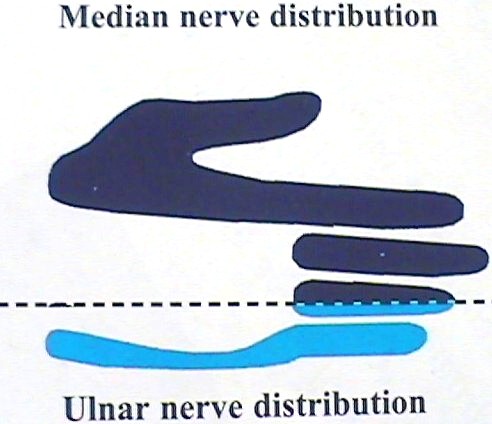
Understanding Ulnar Wrist Pain
The ulna, the smaller of the two forearm bones, runs along the same side as the pinkie finger. When patients experience ulnar sided wrist pain—discomfort concentrated on the outer wrist near the ulna—it often stems from structural damage or nerve involvement. This type of outer wrist pain is relatively common among adults, particularly men between their late twenties and forties. In many cases, it follows trauma such as a fall onto an outstretched hand, with or without a wrist fracture.
A successful ulnar wrist pain treatment plan begins with an accurate history and physical examination. When conducted carefully, this process leads to significant improvement or even resolution in most cases. In fact, advancements in wrist pain treatment—particularly in arthroscopic surgical techniques—have dramatically improved patient outcomes over the past decade.
Left untreated, chronic ulnar wrist pain can cause ongoing discomfort, reduced grip and pinch strength, sleep disruption, and diminished hand function. In turn, this often leads to decreased productivity in both daily life and work-related tasks.
Anatomy
The wrist, or carpus, is a complex joint composed of eight small bones that function together with the ends of the two forearm bones—the radius and the ulna. Wrist motion occurs in four primary directions: upward (dorsal), downward (palmar), and side-to-side (radial and ulnar). These movements are essential for grip strength, dexterity, and everyday hand function.
The ulnar side of the wrist, associated with ulnar wrist pain, receives nerve supply primarily from the ulnar nerve. In contrast, the radial side is innervated by the median, superficial radial, and posterior interosseous nerves. When the ulnar nerve becomes compressed—either at the wrist or more commonly at the elbow—it can lead to ulnar sided wrist pain, numbness, burning, or aching in the outer wrist or hand. Patients often report decreased tolerance for activities such as writing, gripping, or typing, especially in cases of chronic ulnar wrist pain.
Understanding this nerve distribution is critical in determining the correct wrist pain treatment, particularly for individuals suffering from persistent outer wrist pain.
Differential Diagnoses & Causes
1) Ulnar Tunnel Syndrome
Ulnar Tunnel Syndrome is a condition that causes numbness, burning, clumsiness, and ulnar sided wrist pain, particularly on the small finger side of the hand. These symptoms often appear concurrently with those of carpal tunnel syndrome, making it essential to carefully evaluate for ulnar nerve entrapment at the cubital tunnel or Guyon’s canal.
Guyon’s canal, also known as the ulnar tunnel, is located directly adjacent to the carpal tunnel and separated by a septum. Interestingly, a standard carpal tunnel release procedure often also decompresses the ulnar nerve within Guyon's canal. This overlap explains why many patients experience relief from outer wrist pain and hand symptoms without the need for additional ulnar tunnel surgery.
A useful analogy: decompressing the carpal tunnel is like removing extra passengers from an overcrowded bench seat—once the pressure is relieved, the remaining structures have more space and function more comfortably.
Studies using CT and MRI imaging show that carpal tunnel release increases the tunnel’s volume by approximately 25%, effectively relieving pressure. Isolated ulnar tunnel decompression is rarely necessary. When it is, we remain alert to possible causes like a ganglion cyst within the canal.
Medical literature, including work by Richman and Gelberman (1989), supports this view. While their interpretation involved structural changes to Guyon's canal (from a trapezoid to an oval), our clinical experience suggests the decompression effect is more about space redistribution than shape change.
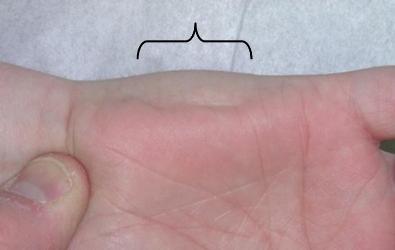
Pressure on the ulnar nerve causing the muscle to spasm.
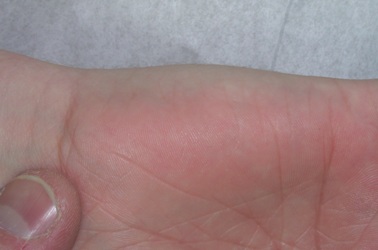
No pressure on the ulnar nerve.
2) Cubital Tunnel Syndrome
Cubital Tunnel Syndrome is caused by compression of the ulnar nerve at the elbow. It most commonly affects individuals over the age of 30 and appears roughly three times more frequently in women than in men. A key contributing factor is habitual sleeping with the elbow in a bent (flexed) position, which increases pressure on the nerve.
While Cubital Tunnel Syndrome often presents with numbness or tingling in the fingers, it can also contribute to ulnar wrist pain or discomfort radiating down the arm to the outer wrist. Early recognition of these patterns is important for selecting the most effective wrist pain treatment, especially if symptoms become chronic or interfere with daily function.

Improper Sleep Posture
3) Torn Triangular Fibrocartilage (TFCC)
A torn Triangular Fibrocartilage Complex (TFCC) is one of the most frequent causes of ulnar wrist pain, particularly in active individuals or those with a history of wrist trauma. Patients typically experience localized tenderness on the top of the wrist, and symptoms often intensify with ulnar deviation (movement of the hand toward the pinkie side), gripping, twisting, or impact activities like pounding.
This form of ulnar sided wrist pain is commonly confirmed through an arthrogram (dye injection study) or direct visualization during wrist arthroscopy, which remains the most accurate diagnostic method. Although MRI scans may also detect a TFCC tear, we have found them less reliable and more costly. When visible swelling is present, it often reflects synovitis—an inflammatory response due to joint or tendon lining engorgement.
If left untreated, a torn TFCC can lead to chronic ulnar wrist pain and impaired function, making early and precise diagnosis essential. Proper wrist pain treatment often requires targeted intervention based on the severity of the tear and the patient’s activity level.
Outcome of Surgery for Torn TFCC
| Procedure | Surgeon | Outcome |
| Arthroscopic Trimming | Melone 1991 | 83% Good/Excellent |
| Osterman 1990 | 88% Good/Excellent | |
| Ulnar Shortening | Melone 1998 | 92% Good/Excellent |
| Hulsizer 1997 | 91% Excellent |
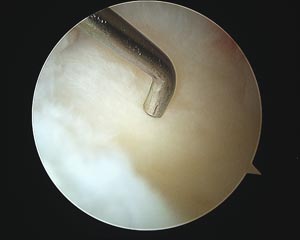
Example of normal TFCC
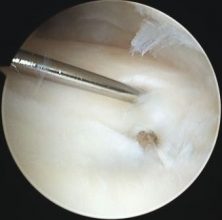
Example of torn TFCC
4) Kienbock’s Disease
Kienbock’s Disease refers to a painful loss of blood supply (bone infarct) in the lunate bone of the wrist. This rare condition can lead to progressive wrist dysfunction and is a potential cause of ulnar wrist pain, especially when the lunate collapses and affects neighboring structures on the ulnar side of the wrist. Unfortunately, the exact cause of Kienbock’s remains unclear.
Treatment depends on the stage of disease progression. In earlier stages, the goal is to unload the lunate and reestablish blood flow—often through the surgical insertion of a vascularized bone graft or artery. When the lunate bone has already deteriorated, salvage procedures such as Proximal Row Carpectomy (PRC) or wrist fusion may be necessary.
While various wrist pain treatment approaches exist for Kienbock’s, overall patient satisfaction averages around 70%, indicating the need for continued refinement and individualized care.
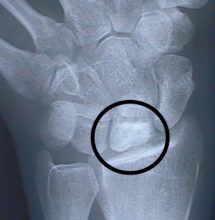
Bone appears more solid due to loss of blood flow causing it to die and crumble.
5) Ulnocarpal Abutment
Ulnocarpal abutment, also called ulnar impaction syndrome, is a structural cause of ulnar wrist pain. It occurs when the ulna—one of the forearm bones—impacts or grinds against the small wrist bones, especially the Triangular Fibrocartilage Complex (TFCC). This mechanical contact often leads to chronic ulnar wrist pain and degeneration of the surrounding soft tissue.
This condition most commonly arises after a wrist fracture heals with improper alignment, leaving the ulna longer relative to the radius than it was prior to injury. Degenerative growth disturbances can also lead to this misalignment. The result is excessive pressure on the ulnar side of the wrist, which over time crushes or tears the TFCC.
Precise diagnosis is critical for effective ulnar wrist pain treatment, especially when symptoms become persistent. Treatment may include surgical shortening of the ulna to restore joint balance and alleviate pressure.
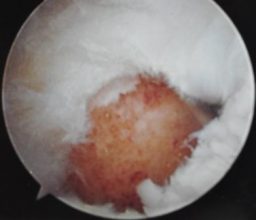
End of trimmed ulna as seen through hole in TFCC
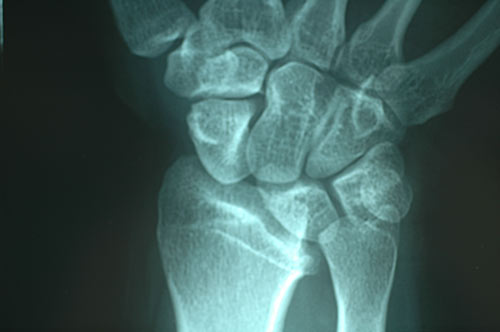
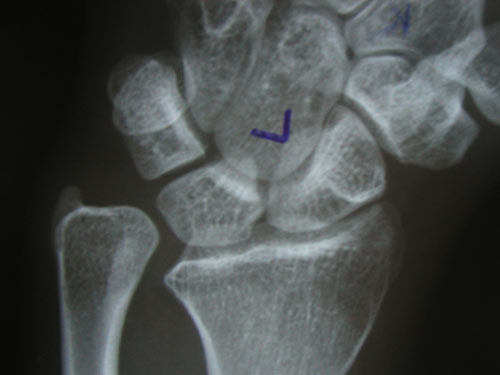
6) Ulnar Artery Thrombosis (Hypothenar Hammer Syndrome)
Ulnar artery thrombosis, also known as Hypothenar Hammer Syndrome, is a rare vascular condition that can lead to fingertip complications. It most commonly affects individuals over the age of 50—particularly heavy smokers—who frequently engage in repetitive hand-impact activities such as hammering, pounding, or using tools.
In these patients, clotting of the ulnar artery can reduce blood flow to the fingers, often resulting in fingertip lesions or discoloration.
Treatment for this form of wrist pain often involves addressing the underlying vascular compromise and modifying lifestyle or occupational factors contributing to repetitive trauma.
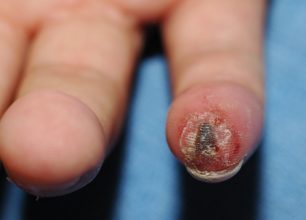
Finger tip ulcer at different stages of healing after circulation cut off by tiny clots
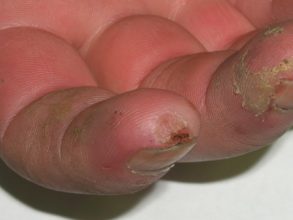
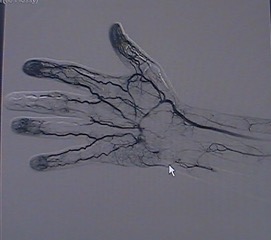
Arthrogram showing blocked ulnar artery
7) Ganglion Cyst
A ganglion cyst is a fluid-filled, degenerative sac that often develops from a joint or tendon sheath. These cysts are quite common on the wrist. While many ganglion cysts are painless, some can cause wrist pain or localized discomfort—especially if they press on surrounding nerves or soft tissue structures.
When symptoms persist or interfere with function, surgical removal is typically the most effective wrist pain treatment. Though generally successful, there is about a 15% chance of recurrence. Identifying whether a ganglion is contributing to outer wrist pain is important, especially in cases of unclear or overlapping diagnoses
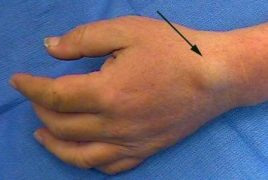
8) Piso-Triquetral Arthritis
Piso-triquetral arthritis is a relatively uncommon form of degenerative joint disease that occurs between the pisiform and triquetrum bones. The pisiform is considered a vestigial or accessory bone—it doesn’t serve a critical function—which is why its removal is often the most effective wrist pain treatment when this condition causes discomfort.
Patients with this arthritis typically report wrist pain, especially with pressure or movement involving the heel of the hand. If the pain is part of a broader pattern of joint degeneration, non-steroidal anti-inflammatory drugs (NSAIDs) may offer partial relief. However, when symptoms persist, surgical excision of the pisiform is a simple, low-risk procedure that often results in complete elimination of pain with minimal recovery time.
Patients whose x-ray is included here for illustration underwent removal of the pisiform with complete elimination of their pain and minimal discomfort.
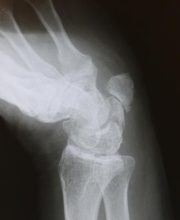
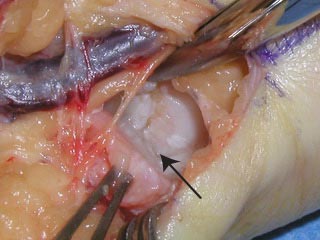
9) Extensor Carpi Ulnaris Tendinosis
Extensor Carpi Ulnaris (ECU) tendinosis is an inflammatory condition that affects the tendon of the ECU muscle, which plays a critical role in lifting the wrist and tilting it. While the exact cause of ECU tendinosis is not fully understood, it is similar to de Quervain’s tendinosis, which occurs on the thumb side of the wrist.
Historically considered rare, wrist pain due to ECU tendinosis has become more frequently diagnosed in recent years. Patients often report chronic wrist pain that worsens with lifting or repetitive wrist motion.
Initial wrist pain treatment typically involves a cortisone injection to reduce inflammation. When this does not provide adequate relief, a simple outpatient procedure—performed through a small, 1-inch incision on the top of the wrist—can eliminate the pain quickly. This surgery requires no postoperative immobilization and usually results in minimal scarring.
Some patients may experience temporary numbness near the incision site due to the proximity of the dorsal cutaneous branch of the ulnar nerve, which is carefully protected during surgery. Notably, this condition occurs equally across occupational backgrounds, from manual laborers to office workers.
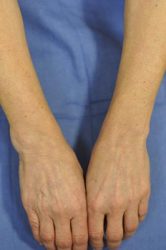
Note the swelling in the exterior of the wrist on the left
10) Carpal Instability (Lunotriquetral Instability)
The wrist joint is made up of eight small bones, which articulate with the two forearm bones—the radius and ulna—as well as the metacarpals of the hand. On the ulnar side of the wrist, between the lunate and triquetrum bones, a rare condition called lunotriquetral instability can develop. This type of carpal instability often causes ulnar wrist pain and is typically triggered by trauma, such as falling on an outstretched hand.
When ligaments between these wrist bones are disrupted, joint mechanics become unstable, leading to pain, weakness, and diminished grip strength. If not properly treated, this form of ulnar sided wrist pain can become chronic.
Diagnosis is confirmed through imaging—such as X-rays, MRI, or wrist arthroscopy. Once identified, the most reliable wrist pain treatment is fusion of the lunotriquetral joint, which stabilizes the wrist and helps eliminate pain caused by abnormal movement.
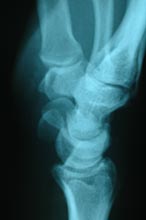
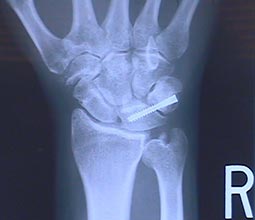
Advanced Ulnar Wrist Pain Treatment in Nebraska
At the Nebraska Hand & Shoulder Institute, we provide expert care and advanced solutions for patients suffering from ulnar wrist pain. Whether you're dealing with recent trauma, a degenerative condition, or chronic wrist pain, our treatment is tailored to your unique diagnosis and lifestyle needs. We proudly serve patients across Omaha, Lincoln, and Grand Island, Nebraska.
Our comprehensive approach begins with a detailed physical exam and a review of your symptoms. We localize the primary source of discomfort and utilize state-of-the-art diagnostics, including X-rays and MRI scans, to rule out conditions such as avascular necrosis. When ligament damage is suspected, we may recommend arthrography (a dye injection study) or wrist arthroscopy for a more precise assessment.
Your wrist pain treatment plan will be customized based on the underlying cause—whether it stems from ligament tears, trauma, degeneration, or nerve compression. One common procedure involves trimming the Triangular Fibrocartilage Complex (TFCC), which is often the source of wrist pain. This minimally invasive outpatient technique uses small wrist punctures to insert a fiberoptic scope and surgical tools, offering excellent results with minimal downtime.
In cases of ulnocarpal abutment, treatment may involve ulna bone shortening. This involves removing a small wedge of bone and stabilizing the area with a metal plate and screws. Most patients heal in 8 to 12 weeks without requiring a cast, thanks to secure internal fixation.
For patients with joint degeneration or wrist instability, limited carpal fusion or Proximal Row Carpectomy (PRC) may be the best path forward. These procedures aim to reduce pain while preserving as much motion as possible.
With over a decade of experience, Dr. Ichtertz brings unmatched expertise to every case. Whether you’re seeking relief from wrist pain, chronic ulnar wrist pain, or general wrist dysfunction, trust our team to deliver precise and lasting results.
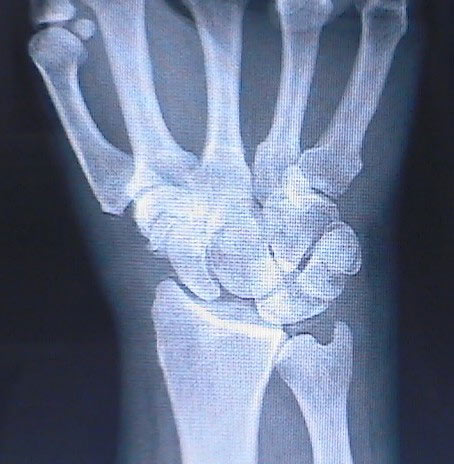
Proximal Row Pre-Op
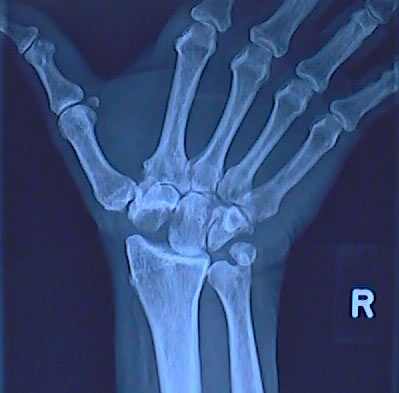
Proximal Row Post-Op
Risks of Surgery
Most wrist procedures for wrist pain treatment are minimally invasive and performed on an outpatient basis with low postoperative discomfort. However, as with any surgery, there are potential risks to consider. These may include infection, nerve irritation or injury, or the development of new or increased pain.
In procedures such as wrist fusion, there is a small chance of non-union (failure of the bones to heal), particularly among patients who smoke. In such cases, a follow-up procedure may be required. Some individuals may also develop prominent scarring, which tends to be more visible in people with darker skin tones.
Our team carefully weighs these risks and communicates them thoroughly to ensure each patient makes an informed decision about their wrist pain treatment plan.
Schedule Your Wrist Pain Appointment Today
Ulnar wrist pain can be difficult to diagnose and even harder to live with—but you don’t have to face it alone. At Nebraska Hand & Shoulder Institute, Dr. Ichtertz and his experienced team specialize in identifying the precise cause of your discomfort and providing proven solutions, whether you're experiencing chronic ulnar wrist pain or recurring outer wrist pain from daily activities.
Our treatment philosophy emphasizes conservative, non-surgical approaches whenever appropriate. We often begin with a combination of anti-inflammatory medications, targeted injections, and wrist splinting. While physical therapy is not our primary recommendation for most hand and wrist conditions, we focus instead on fast-acting strategies that minimize downtime and restore function.
We believe in keeping you active, productive, and pain-free. Our individualized plans are designed to relieve ulnar wrist pain and preserve your hand strength and motion.
Don't let persistent wrist issues limit your life. Schedule your consultation today with the Nebraska Hand & Shoulder Institute and take the first step toward lasting wrist pain treatment.
Allan CH, Joshi A, Lichtman DM: Kienböck’s disease: diagnosis and treatment. Am Academy Ortho Surg 2001; 9:128-136.
Bain GI, Pugh MW, MacDermid JC, Roth JH: Matched hemiresection interposition arthroplasty of the distal radioulnar joint. J Hand Surg 1995; 20A:944-950.
Begley BW, Engber WD: Proximal row carpectomy in advanced Kienböck’s disease.
Chidgey LK: The distal radioulnar joint: problems and solutions. J Am Acad Ortho Surg 1995; 3:95-109.
Constantine KJ, Tomaino MM, Herndon JH, Sotereanos DG: Comparison of ulnar shortening osteotomy and the wafer resection procedure as treatment for ulnar impaction syndrome. J Hand Surg 2000; 25A:55-60.
DiBenedetto MR, Lubbers LM, Coleman CR: Long-term results of the minimal resection Darrach procedure. J Hand Surg 1991; 16A:445-450.
Hulsizer D, Weiss A-PC, Akelman E: Ulna-shortening osteotomy after failed arthroscopic debridement of the triangular fibrocartilage complex. J Hand Surg 1997; 22A:694-698.
Kirschenbaum D, Coyle MP, Leddy JP: Chronic lunotriquetral instability: diagnosis and treatment. J Hand Surg 1993; 18A:1107-1112.
Minami A, Kato H: Ulnar shortening for triangular fibrocartilage complex tears associated with ulnar positive variance. J Hand Surg 1998; 23A:904-908.
Osterman AL: Arthroscopic debridement of triangular fibrocartilage complex tears. J Arthro Related Surg 1990; 6(2):120-124.
Palmer AK: Triangular fibrocartilage disorders: injury patterns and treatment. J Arthro Related Surg 1990; 6(2):125-132.
Palmer AK, Werner FW, Glisson RR, Murphy DJ: Partial excision of the triangular fibrocartilage complex. J Hand Surg 1988; 13A;403-406.
Palmer AK, Werner FW: The triangular fibrocartilage complex of the wrist - anatomy and function. J Hand Surg 1981; 6(2):153-162.
Pin PG, Young VL, Gilula LA, Weeks PM: Management of chronic lunotriquetral ligament tears. J Hand Surg 1998; 14A:77-83.
Richman JA, Gelberman RH, Rydevik BL et al. Carpal tunnel syndrome: morphologic changes after release of transverse carpal ligament. J Hand Surg 1989; 14A:852-857.
Shin AY, Sheetz KK, Bishop AT, Berger RA: Vascularized pedicled bone grafts from the distal radius: technique and results of treatment for scaphoid nonunion and Kienböck’s disease. Mayo Clinic 1997.
Simmons SP, Tobias B, Lichtman DM: Lunate revascularization with artery implantation and bone grafting. J Hand Surg 2009; 34A:155-160.
Tomaino MM: The importance of the pronated grip x-ray view in evaluating ulnar variance. J Hand Surg 2000; 25A:352-357.
Watanabe T, Takahara M, Tsuchida H, Yamahara S, Kikuchi N, Ogino T: Long-term follow-up of radial shortening osteotomy for Kienböck’s disease. JBJS Am 2008; 90:1705-1711.



